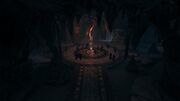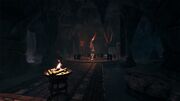The Cult of Kosmos was a secretive cabal operating throughout and controlling ancient Greece and the surrounding regions. The Cult worshiped a deity called Kosmos. The Cult also operated in seven branches comprising several Adepts, with each branch led by a individual dubbed as the Sage.[3]
The Cult of Kosmos was one of several antecedents to the Templar Order.
History
Founding
The Cult of Kosmos was founded at some point after the meeting of Hermes Trismegistus and Pythagoras, which had led to the foundation of the Cult of Hermes. Disaffected with the Cult of Hermes' ways, a number of followers splintered from the group and formed their own collective; the Cult of Kosmos, led by the Ghost of Kosmos.[2]
Greco-Persian Wars
By the 5th century BCE, the Cult had formed a partnership of sorts with the Order of the Ancients in Persia. Though both organizations independently of one another, their aims often aligned; together, they sought to install King Xerxes I of Persia as overlord in Greece,[4] and as a result the Cult supported his conquests, seeing him as a means to unite all Greece as one under his ordered rule.[5]
In 480 BCE, when Leonidas I of Sparta consulted the Pythia about going to war against the Persians, the whole Cult confronted the Spartan King, warning him not to oppose their plans. Nevertheless, Leonidas chose to disregard their threats and fight against the invaders, an act of defiance which cost him his life.[6]
Following Leonidas' defiance, the Cult grew determined to wipe out his bloodline due to its potential for interference.[5] In 446 BCE, through their manipulation of the Pythia Praxithea,[7] the Cult spread word that the youngest grandchild of Leonidas, Alexios, would bring ruin to Sparta and, as a result, the infant was sentenced to execution. Concurrently, Alexios' sister, Kassandra, tried to save her brother only to push him and the executioner over the cliff of Mount Taygetos, for which she was dropped to her death as well.[8]
The fall failed to kill the children, however. While Kassandra fled and went into exile, her mother Myrrine took Alexios to the Sanctuary of Asklepios in Argolis to seek medical aid. The priests at the sanctuary, foremost among them Mydon, did what they could for the mother and child, but ultimately convinced Myrrine that it was best to leave the badly-injured child to the mercies of the gods. She did so, and when she had turned her back to Alexios, the Cultist Chrysis took him under her wing, healed him, and raised Alexios like so many others to be a part of the Cult.[9] Alexios was subsequently renamed Deimos, and the Cult saw him as a weapon rather than just another foot soldier.[1]
Peloponnesian War
Several decades later, the Cult orchestrated the Peloponnesian War in an effort to achieve control of Greece amidst the conflict of the country's two most notable poleis, Athens and Sparta. At the same time, they discovered that Kassandra was operating as a misthios on Kephallonia. Initially, the Cult desired to have Kassandra killed but Elpenor of the Eyes of Kosmos branch convinced them to instead hire her and have her assassinate her stepfather Nikolaos,[10] to avert an immediate Spartan victory over Athens. But in doing so, Elpenor exposed the Cult's existence to Kassandra, who decided to hinder the Cult's plans for control over Greece by demolishing the Cult as a whole.[5]
In 431 BCE, the Cult held a meeting after what had been a good while in the Sanctuary of Kosmos. Unbeknownst to them, Kassandra infiltrated their meeting.[1]
Foundations and Beliefs
The Cult of Kosmos were not polytheistic and had a deistic belief system. According to Aspasia, the nations in Greece were already chaotic and the Cult wanted to use a controlled war so as to create a clean slate on which to establish an orderly and unified Greek Nation, one where violence would be absent and the people could move towards a more rational and developing society, which would be built by the people for the people. Aspasia mentioned this would require a very wise and philosophical king.[5]
Some members of the Cult did, however, idolize and worship the people within the Bloodline, truly believing them to be actual demigods, such as Deimos. The members of the Cult soon grew chaotic and greedy and used the Chaos to earn massive amounts of profit and political power. Eventually this led to the Cult becoming corrupted with greed and personal gain, and these individuals enabled Deimos to become their violent leader. Aspasia, while still the leader of the Cult but unable to do anything to stop them, opted to use Kassandra to help her destroy the Cult so she could resume their original goal.[5]
Members
Peloponnesian War
- Aspasia (The Ghost of Kosmos, defected)
- Deimos (The Demigod, Sage; defected)
Eyes of Kosmos
- Main article: Eyes of Kosmos
The Silver Vein
- Main article: The Silver Vein
Delian League
- Main article: Delian League
Peloponnesian League
- Main article: Peloponnesian League
Gods of the Aegean Sea
- Main article: Gods of the Aegean Sea
Worshippers of the Bloodline
- Main article: Worshippers of the Bloodline
Heroes of the Cult
- Main article: Heroes of the Cult
Allies and puppets
- Order of the Ancients[11]
- Oracle of Delphi
- Andras
- Antonide
- Diokles
- Doctor
- Dolops' Landlord
- Drakios
- Glaukos
- Heremos
- Karpos
- Klitos
- Krethos
- Onomakles
- Polemion
- Priam
- Sitalkes
- The Great Euthymos
- The Stalker
- Thalestris
- Tisandros
- Followers of Ares
- Priests of Asklepios
- Champions of Boeotia
- Aigle the Great Cat
- Astra
- Sosipatros the Archon's Servant
- The Poisoner
Trivia
- κόσμος (kosmos) is a word that stems from ancient Greek origin, and it means both 'order' and 'world', mainly because the ancient Greeks thought that the world was perfectly harmonious and impeccably put in order.
- While the leaders of the Cult were dubbed Sages, this terminology does not have any connection to the Sages, the human reincarnations of the Isu Juno's husband Aita.
- The cultists are wearing theatrical masks known from ancient Greek theater, and called πρόσωπον (prósōpon), which literally means 'face, mask, visage'.
- Each Cultist icon has up to five states: hidden (no icon), masked icon, ready to unveil, unveiled, and defeated.
- The hidden icon shows only the Cult's symbol. The masked icons are usually revealed by hunting other members of the Cultist's branch.
- The masked icon displays a hint directing the player to the definitive clue that renders them "ready to unveil." The only thing discernible is the Cultist's gender, which is determined by the type of mask they wear.
- When "ready to unveil," the masked icon lights up with a white ring. Holding the appropriate button unveils the Cultist, usually with a boastful quote.
- The "unveiled" icon shows the Cultist's identity ringed in gold. With few exceptions, this allows them to be tracked on the map from anywhere in the world and hunted down, though unveiling them is not always required to defeat them.
- The "defeated" state shows the Cultist's icon ringed in red. In their submenu, the Cultist is slumped over with their back facing the camera, much like a defeated mercenary.
- The clues taken from defeated Cultists can also be read in the submenu for any Cultist they "direct" the player to but don't necessarily unveil, unless that Cultist is already "ready to unveil." ex.) The clue taken from Chrysis can direct the player to kill and loot any of the Followers of Ares to find the clue that unveils Harpalos, however it is likely the player will have already done so. In this case, only the "unveiling" clue for Harpalos can be read in his submenu, not the "directing" clue from Chrysis. On a similar note, any unveiling clue that is obtained after its corresponding Cultist is defeated (or unveiled by another means) cannot be read in their submenu.
- In some cases, the unveiling clue simply replaces the directional hint. ex.) Zoisme's unveiling clue can be found in a wolf den very near the Cult's meeting place in Phokis, to which the player is directed by the letters obtained during The Serpent's Lair. Whether the clue is obtained before or after the quest, it becomes the only clue in her submenu.
- Lastly, some Cultists have no "hidden" or "masked" state and go straight to "ready to unveil." These include the handful of Cultists who are definitively exposed after 'The Serpent's Lair' and are intended as the starting points of the player's hunt. Elpenor and Epiktetos are present in the menu immediately in the "defeated" state, given the timing of their demises.
- It's mentioned that the bandit group known as The Dagger was better organized, connected, and funded than the common run of the mill bandit groups, but what their connection to the Cult of Kosmos is left very vague in-game, if there indeed was ever even meant to be one.[12]
- According to The Art of Assassin's Creed: Odyssey, the Cult based their snake symbology on the myth of the giant snake Python, and as a whole met annually to perform their rituals and discuss their plans.
Gallery
Appearances
- Assassin's Creed: Odyssey (first appearance)
- Legacy of the First Blade: Hunted (mentioned only)
- Legacy of the First Blade: Shadow Heritage (mentioned only)
- Legacy of the First Blade: Bloodline
References
- ↑ 1.0 1.1 1.2 Assassin's Creed: Odyssey – The Serpent's Lair
- ↑ 2.0 2.1 Assassin's Creed: Odyssey novel
- ↑ Assassin's Creed Odyssey: Official Game Guide
- ↑ Assassin's Creed: Odyssey – Legacy of the First Blade: Bloodline
- ↑ 5.0 5.1 5.2 5.3 5.4 Assassin's Creed: Odyssey
- ↑ Assassin's Creed: Odyssey – Bully the Bullies
- ↑ Assassin's Creed: Odyssey – Sins of the Past
- ↑ Assassin's Creed: Odyssey – Debt Collector
- ↑ Assassin's Creed: Odyssey – The Priests of Asklepios
- ↑ Assassin's Creed: Odyssey – Penelope's Shroud
- ↑ Assassin's Creed: Odyssey – Legacy of the First Blade: Shadow Heritage
- ↑ Assassin's Creed: Odyssey – The Taxman Cometh
| |||||||||||||||||||||||||||||||||||||||||||||||||||||||
















